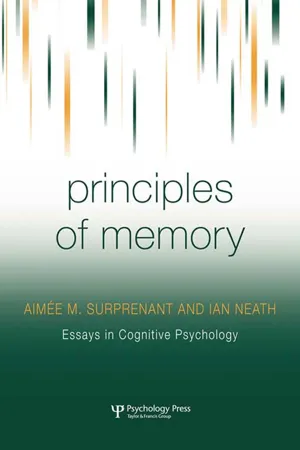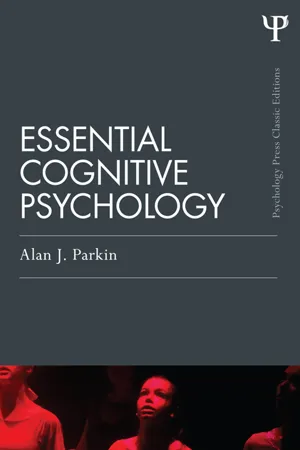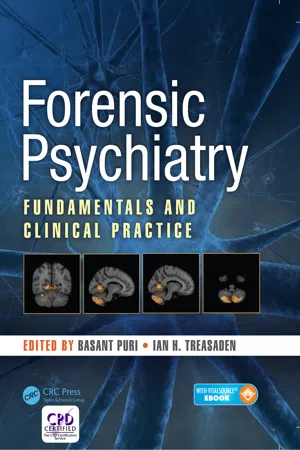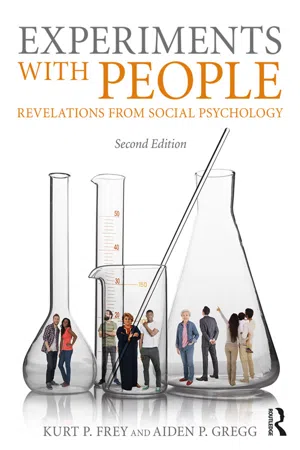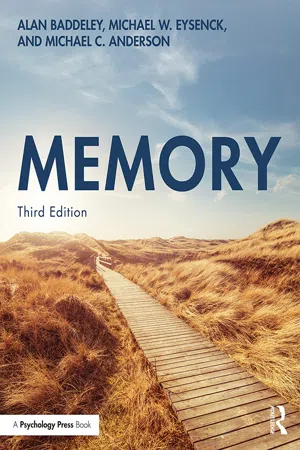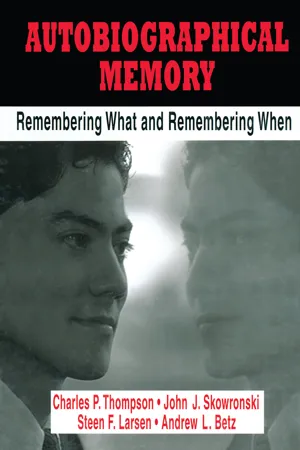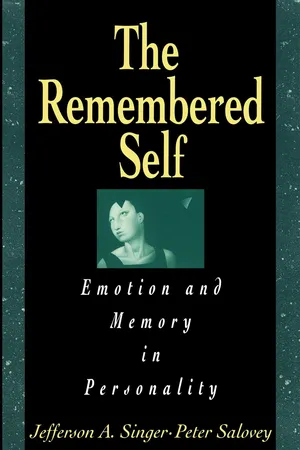Psychology
Reconstructive Memory
Reconstructive memory refers to the process by which memories are altered, revised, or influenced by new information or experiences. This phenomenon can lead to inaccuracies or distortions in one's recollection of past events. It is a key concept in understanding the fallibility of human memory and has implications for eyewitness testimony and the reliability of personal accounts.
Written by Perlego with AI-assistance
Related key terms
Related key terms
1 of 4
Related key terms
1 of 3
11 Key excerpts on "Reconstructive Memory"
- eBook - ePub
- Geoffrey Cubitt(Author)
- 2013(Publication Date)
- Manchester University Press(Publisher)
13 and it seems therefore unwise to downplay cognitivity completely. Historians have grown used to affirming that memory is a reconstructive process, less used as yet to thinking through what they mean by this (beyond perhaps a vague notion that what it means is that remembered events are always remembered ‘from a present standpoint’). Cognitive psychologists have no monopoly of wisdom in this area (any more than historians have an exclusive right to talk about historical processes of historical change). But their efforts to conceptualize remembering as a cognitive process in individual minds do yield models that can help historians to formulate their own, probably more socially focused, conceptions of mnemonic processes. In the later stages of this chapter and in the next, I shall move from general discussion of memory as a reconstructive mental activity, through to discussion of issues of selfhood and narrativity, and then to a consideration of memory’s social and cultural aspects. Such a sequence will bring the three approaches to personal memory that I have outlined successively into focus; the overall aim, however, is not to affirm the priority of any of these approaches over any other, but to show how elements in them can be blended together.Memory as reconstruction
From the standpoint of the remembering individual, remembering seems to be at once a mental activity (something one does) and a mental experience (something one feels). Any conscious mental activity has its experiential dimension, of course, but in the case of remembering the point is not merely banal, for the term is used to cover two actually very different kinds of mental experience, one of which feels more ‘active’ than the other. Aristotle famously distinguished memoria from anamnesis .14 The first of these terms denoted the kind of remembering that takes the apparent form of retention or preservation: the persistence within the mind of impressions formed at an earlier moment. The second denoted the kind of remembering that is experienced as a deliberate action of retrieval or recovery: the effortful bringing to the surface of the mind of things otherwise latent or seemingly forgotten. For Aristotle, anamnesis presupposed memoria , since no amount of effort could bring to consciousness things of which the mind had previously retained no trace whatever. Some such distinction between two presumably connected but phenomenologically different modes of remembering – the one ostensibly continuous and passively retentive, the other intermittent and effortfully geared to retrieval – has been a common feature of theorizing about memory since Aristotle wrote. Saint Augustine, for example, developed the metaphor of memory as a storehouse, in which the sensory and intellectual impressions of past experience are preserved awaiting future use. There follows a comical account of the vagaries of anamnesis - eBook - ePub
- Aimée M. Surprenant, Ian Neath(Authors)
- 2013(Publication Date)
- Psychology Press(Publisher)
6CHAPTERThe Reconstruction Principle
From the content point of view the original never is and never can be literally duplicated. Functions, on the other hand, persist as well in mental as in physical life.—J. R. Angell6.1 Principle 4: The Reconstruction Principle
Memory, like all other cognitive processes, is inherently constructive. Information from encoding and cues from retrieval, as well as generic information, are all exploited to construct a response to a cue. Work in several areas has long established that people will use whatever information is available to help reconstruct or build up a coherent memory of a story or an event (e.g., Bartlett, 1932). However, although these strategies can lead to successful and accurate remembering in some circumstances, the same processes can lead to distortion or even confabulation in others (Estes, 1997). There are a great many studies demonstrating the constructive and reconstructive nature of memory, and the literature is quite well known. We begin by briefly reviewing the noncontroversial aspects of this area before expanding it into what might be seen as slightly more adventurous territory: semantic memory, immediate or short-term memory, very short-term memory, and sensory or iconic memory. If this property of memory is to be considered a principle by our definition, it should hold across all domains of memory.6.2 Classic Demonstrations
A classic example of Reconstructive Memory concerns the ability to reproduce a simple line drawing. (See Figure 6.1 .) Carmichael, Hogan, and Walter (1932) presented simple line drawings to subjects and told half of the subjects that the drawing looked like one particular object and told the other half of the subjects that the drawing looked like a second, different object. For example, one group of subjects might be told that the drawing resembled a pair of eyeglasses whereas the other group was told the drawing looked like a set of dumbbells. At a later test, the subjects were asked to draw the original figure as accurately as possible. Examples of reproduced figures can be seen in Figure 6.1 - eBook - ePub
- Alan J. Parkin(Author)
- 2014(Publication Date)
- Psychology Press(Publisher)
We have all experienced reconstruction in memory. Thus, if asked what is the capital of Peru, we may initially be unable to answer but, when given the clue “begins with L”, we can construct a restricted candidate list which hopefully will contain the correct answer “Lima”. In producing accounts of retrieval, some psychologists have sought to capture this reconstructive process.An important aspect of Reconstructive Memory is that it allows for incorrect information to be introduced. Very often this takes the form of a “normalisation” process in which the contents of an event are restructured according to some general idea as to what might have happened in a given situation. This was famously demonstrated by Bartlett (1932) in his book Remembering. Bartlett described an experiment in which participants heard an unfamiliar folk story and were then required to remember it on a number of successive occasions. Bartlett found that, as time progressed, participants introduced more and more of their own knowledge as a means of filling gaps created by forgetting the original information. Thus if the story had mentioned “canoes”, participants would actually recall “boats”. Similarly, unfamiliar phrases such as “something black came out of his mouth” would be replaced with the more common phrase “foamed at the mouth”.To account for these results Bartlett made use of the term schema (pl. schemata). This had first been used by the physiologist Henry Head to explain how various parts of our body are co-ordinated to achieve a certain goal, thus there might be an overall “body image” for sitting, standing and so on. Bartlett argued that schemata could also exist in psychological terms. Thus, in trying to remember a particular situation one might evoke a schema typical of that situation, to guide remembering. Thus, in recalling the War of the Ghosts, various schemata were employed to fill in the missing memories. The idea of schema had an immediate impact on the psychology of memory (see Parkin, in prep.). We will return to the idea of schemata in a later chapter.Clarifying our termsUp until now we have used terms like “recall” and “recognition” fairly freely but for this chapter we must use sharper definitions. Essentially there are three types of conscious, explicit, remembering: - eBook - ePub
- Alan J. Parkin(Author)
- 2013(Publication Date)
- Psychology Press(Publisher)
We have all experienced reconstruction in memory. Thus, if asked what is the capital of Peru, we may initially be unable to answer but, when given the clue ‘begins with L’, we can construct a restricted candidate list which hopefully will contain the correct answer ‘Lima’. In producing accounts of retrieval, some psychologists have sought to capture this reconstructive process.An important aspect of Reconstructive Memory is that it allows for incorrect information to be introduced. Very often this takes the form of a ‘normalisation’ process in which the contents of an event are restructured according to some general idea as to what might have happened in a given situation. This was famously demonstrated by Bartlett (1932) in his book Remembering. Bartlett described an experiment in which participants heard an unfamiliar folk story and were then required to remember it on a number of successive occasions. Bartlett found that, as time progressed, participants introduced more and more of their own knowledge as a means of filling gaps created by forgetting the original information. Thus if the story had mentioned ‘canoes’, participants would actually recall ‘boats’. Similarly, unfamiliar phrases such as ‘something black came out of his mouth’ would be replaced with the more common phrase ‘foamed at the mouth’.To account for these results Bartlett made use of the term schema (pl. schemata). This had first been used by the physiologist Henry Head to explain how various parts of our body are co-ordinated to achieve a certain goal, thus there might be an overall ‘body image’ for sitting, standing, and so on. Bartlett argued that schemata could also exist in psychological terms. Thus, in trying to remember a particular situation one might evoke a schema typical of that situation, to guide remembering. Thus, in recalling the War of the Ghosts, various schemata were employed to fill in the missing memories. The idea of schema had an immediate impact on the psychology of memory (see Parkin and Hunkin, 2001). We will return to the idea of schemata in a later chapter.Clarifying our termsUp until now we have used terms like ‘recall’ and ‘recognition’ fairly freely but for this chapter we must use sharper definitions. Essentially there are three types of conscious, explicit remembering: - Nicolae Babuts(Author)
- 2017(Publication Date)
- Routledge(Publisher)
2 Retrieval and RecallClearly, the just-mentioned studies of memory in the neurosciences reveal the close correspondence between imagery and perception. This revelation is significant because it prepares us to understand the form in which memory preserves the perceptual information from the afferent signals and the way it can subsequently retrieve this information. One of the most glaring misunderstandings in some psychological and philosophical studies of memory is the notion, which appears to be popular nowadays, that “The apparently stable objects of memory—the representations of the things being recalled—are not retrieved from some Store-house of Ideas where they have been waiting intact, but rather are constructed on the fly by a computational process.” And further: “What we recall is not what we actually experienced, but rather a reconstruction of what we experienced that is consistent with our current goals and our knowledge of the world” (Westbury and Dennett, 19). Another example of this notion is thatretrieval is almost always more a process of construction than one of simple retrieval. One creates the memory at the moment one needs it, rather than merely pulling out an intact item, image, or story. This suggests that each time we say or imagine something from our past we are putting it together from bits and pieces that may have, until now, been stored separately. Herein lies the reason why it is the rule rather than the exception for people to change, add, and delete things from a remembered event. (Susan Engel. Context is Everything: The Nature of Memory- eBook - ePub
Everyday Thinking
Memory, Reasoning, and Judgment in the Real World
- Stanley Woll(Author)
- 2001(Publication Date)
- Psychology Press(Publisher)
Second, this research originates from social psychology, with its emphasis on bias and distortion (see chap. 9), rather than from the area of memory or cognitive psychology (though M.Ross, 1989, has acknowledged that much of the research in AM suggests great accuracy). This difference is reflected in the emphasis on memory for judged characteristics rather than memory for actual events, in the emphasis on construction and misrepresentation rather than on retrieval per se, and on the role of social theories or assumptions as well as social, interpersonal goals on personal conceptions of one’s life history (see Ross & Buehler, 1994a). In addition, in their most recent account, Ross and Buehler (1994b) explicitly emphasized the social context and the social goals of recalling AM (e.g., the self-presentational goals; see Barclay, 1993a, for a similar position). Finally, there is a recent set of diary studies by Thompson et al. (1996), to be discussed in later sections of this chapter, that also argue for a reconstructive theory of both AM itself and of estimates of the date of the original event. Thompson et al.’s view is that memory for important details of the event starts off as reproductive and later becomes more and more recon-structive, whereas memory for peripheral details is reconstructive from the outset. Along somewhat similar lines, Bahrick (1998; Bahrick, Hall, & Berger, 1996) proposed a supplementary view of Reconstructive Memory, according to which reconstructive processes are brought into play only when reproductive processes fail. Both of these viewpoints may be considered to be partially reconstructive, although it is certainly different from the model with the same label to be discussed next. Model 3: A Partially Reconstructive Alternative W.F.Brewer (1986, 1994) put forward a third compromise viewpoint that he labelled as a partially reconstructive model - eBook - ePub
Forensic Psychiatry
Fundamentals and Clinical Practice
- Basant Puri, Ian H. Treasaden(Authors)
- 2017(Publication Date)
- CRC Press(Publisher)
8The reality of the past 40 years of scientific memory research is that memory is not a matter of passive reproduction of previous experiences, but rather it is intrinsically constructive. That is, our memory is a flexible system, encoded in the patterns of synaptic connectivity between neurons. Throughout life we encounter and experience events that lead to new connections, with changes in the strength of these synapses and ways in which we encode our experiences. We blend, rewrite, and combine new information, often nonconsciously, with information that already exists in storage. Thus, memories are a matter of constructing fragmented remnants of what happened in the past, in a manner that is “sensible” according to the rememberer’s current world view.9As a result, remembering is not infallible, and generally the reliability of memories is questionable. Indeed, we have learned from the science of memory that a number of factors can influence the reliability of memory for autobiographical events. Consider then how the modern view of human memory (MVHM) might inform our decision making in judging memory as evidence.MEMORY FOR SEXUAL VIOLENCE
To understand how damaging reliance on inchoate beliefs about memory can be, at the expense of having knowledge of the MVHM, consider two forms of (common) sexual violence and how the authorities and triers of fact deal with such cases. Currently in UK courts, and in several other countries, there is a steady flow of cases of “historic” sexual abuse (16% of UK rape cases processed by the Crown Prosecution Service involve adults alleging historic abuse as children).10Historic sexual abuse (HSA) refers to those cases in which, typically, an adult recalls abuse that took place years and even decades earlier, usually when he or she was a child or a young teenager. In HSA cases memory is the only evidence. Other evidence, such as social service records, medical records, and reports from teachers and other professionals, is often lacking, incomplete, or unreliable. In many cases, the complainant has not disclosed the alleged abuse, either at the time or since the abuse occurred. In other instances, it has been recalled previously but mentioned in a rather abstract, undetailed form to partners or close friends or perhaps mentioned when the person was a child but these allegations were not believed. Reasons for bringing forward allegations of HSA are variable. These may include the complainant’s belief that “justice should be done,” which has gradually become stronger than his reticence in holding back his memories; there may be an element of anger and revenge associated with the disclosure, and the complainant may be trying to protect other children he judges to be vulnerable; or there may be some other reasons or mix of reasons. Finally, those accused are usually known to the complainant and are typically an adult male and often a father or stepfather. Unfortunately, there are no good statistics on why alleged victims delay their disclosure for so long or who the offenders typically are. These facts are based on the extensive number of HSA cases in which the first two authors have acted as memory expert witnesses.9,11 - eBook - ePub
Experiments With People
Revelations From Social Psychology, 2nd Edition
- Kurt P. Frey, Aiden P. Gregg(Authors)
- 2017(Publication Date)
- Psychology Press(Publisher)
do fall within the bounds of credibility. In such cases, memory-based testimony cannot simply be dismissed out of hand. It seems improbable, on the face of it, that large numbers of patients would allege traumatic abuse without due foundation, or that memories for such abuse would be so vivid were they mere mental fictions. Yet are things as they seem? The stakes are high. On the one hand, every moral person rightly recoils from the prospect of dismissing a genuine case of abuse as bogus. On the other hand, accepting as genuine a false allegation of abuse risks ruining the lives and reputations of those who stand unjustly accused. In the absence of decisive physical evidence, the evidential value of memory-based testimony must be carefully determined. Scientific psychology has played a key role in this regard. As it turns out, its findings tend to justify skepticism about the validity of recovered memories.First of all, the available laboratory evidence does not support the view that people repress unpleasant memories (Holmes, 1990). (Note: Repression differs from suppression in that it is involuntary; see Chapter 22 for more on the effects of voluntary suppression.) Indeed, one of the hallmarks of real traumatic memories, observed in people who have been through verifiable ordeals like wartime killing, is that such memories cannot be forgotten. They intrusively recur during both waking and sleeping (Krystal, Southwick, & Charney, 1995). Admittedly, post-traumatic amnesia does occur but when it does it is global in nature, such that all sorts of events, traumatic and non-traumatic, are forgotten (Schacter & Kilstrom, 1989). However, even if a trauma were selectively forgotten, repression would not be automatically implicated. Everyday forgetting, due to competition from other material or to the decay of memory traces, would be an equally if not more plausible explanation. True, unpleasant autobiographical memories do tend to fade faster than pleasant ones, but repression does not appear to be involved (Walker, Skowronski, & Thompson, 2003). Hence, the prima facie case for recovered memory is not compelling.Moreover, numerous studies attest to the surprising malleability of memory. Taken as a whole, these lend credence to the view that recovered memories may be artificially induced. For example, when people read a list of related words (e.g., bedtime, yawn, pillow), most of them then recall having read, or report recognizing, other thematically related words that did not in fact appear (e.g., sleep; Roediger & McDermott, 1995). Moreover, people’s confidence in the accuracy of their memories, and their feeling of remembering rather than guessing, is no higher for words previously presented than for words falsely identified. Hence, subjective judgments about the validity of memories can go astray when highly consistent mental concepts are activated. - eBook - ePub
- Alan Baddeley, Michael W. Eysenck, Michael C. Anderson(Authors)
- 2020(Publication Date)
- Routledge(Publisher)
Reconstructive Memory refers to this active and inferential aspect of retrieval. Some of the flavour of Reconstructive Memory is given by the following account, which AB, the first author, produced a few days after the experience had taken place.November, 1978
On the train platform I notice a familiar face and I decide to see if I can remember who he is. Two associations occur, the name Sebastian and something to do with children. Sebastian seems to me to be a useful cue, but all it calls up is an association with teddy bears through Evelyn Waugh’s BridesheadKey term
Reconstructive Memory: An active and inferential process of retrieval whereby gaps in memory are filled-in based on prior experience, logic, and goals.Revisited. I also sense there are some associations with a darkish room with books, but nothing clear enough to suggest any useful further search.A little later, for no apparent reason, BABYSITTING pops up and I recall that we were both members of a mutual babysitting group, that his name is indeed Sebastian, although I cannot remember his second name, and that he lives in a road whose location I am quite clear about and in a house which I could visualize easily. A clear image of his sitting-room appears, together with the fact that it contains finely printed books, and that he is by profession a printer. I remember noticing that he has a printing press in one room. I have no doubt that I have identified him.Two days later, it occurs to me that I still have not remembered his surname or the name of the street in which he lives. I have no clues about his name, but know that he lives in either Oxford Road or Windsor Road. I have a colleague who lives in the one that Sebastian does not live in. If I have to guess, I would say that he lives in Oxford Road, and that my colleague lives in Windsor Road. I try again to remember his surname. Sebastian…. Nothing. And then for no obvious reason CARTER appears. It feels right, although not overwhelmingly so. Then the association PENNY CARTER appears as his wife’s name. I am sure that this is correct, reinforcing my belief that his name is Sebastian Carter. - eBook - ePub
Autobiographical Memory
Remembering What and Remembering When
- Charles P. Thompson, John J. Skowronski, Steen F. Larsen, Andrew L. Betz(Authors)
- 2013(Publication Date)
- Psychology Press(Publisher)
CHAPTER SIXReconstructive Memory for TimeTHE TEMPORAL ASPECT OF MEMORIESTo this point we have considered memory for the properties that characterize the content of individual, single episodes. In some ways, our approach is conceptually similar to traditional laboratory research in which words presented to a subject and later used in a memory test make up an experimental episode. However, at least two important differences exist between laboratory and naturalistic memory research. First, personal memories concern natural, meaningful events. Second, memory for these events includes information indicating that the individual who now remembers them was also present to experience them originally. Thus, unlike items in the typical list-learning experiment, personal memories have autobiographical reference (Tulving, 1972) or self-reference (Brewer, 1986; Nelson, 1993).Memory for the “what” of events is, of course, necessary for anybody to have personal memories. However, early memory researchers commonly emphasized an additional feature of personal memories, namely that the events are “expressly referred to the past, thought of as in the past” (James, 1890/1950, p. 650). Similarly, Höffding (1885/1891, p. 135) emphasized “definite reference of the representation to a definite point in time” as a feature of “memory proper,” as opposed to sheer familiarity or recognition. In other words, some awareness of the time of the event, a temporal location that is at least more definite than a feeling of pastness, is required for a genuine personal memory.The importance of time has re-emerged in recent conceptions of personal memory. Tulving (1972) argued that episodic memory contains “information about temporally dated episodes or events, and temporal-spatial relations among these events” (p. 385). In Brewer’s (1986) discussion of the concepts of autobiographical and personal memory, temporal properties were not explicitly mentioned as a defining feature of these types of memory. However, Brewer endorsed Tulving’s statement as a precise description of personal memory; he thus seems to take temporal location as a self-evident ingredient of the definition (but see Brewer, 1994). Nelson (1993) explicitly emphasized time when she wrote that autobiographical memory is “a particular form of episodic memory in which specificity of time and place is significant” (p. 357). - eBook - ePub
Remembered Self
Emotion and Memory in Personality
- Jefferson A. Singer, Peter Salovey(Authors)
- 2010(Publication Date)
- Free Press(Publisher)
2 Self-Defining Memories T his is a chapter about memory, but not about all aspects of human memory. In fact, it is not about the topics that have traditionally preoccupied most psychologists who study memory. It is not about how information is encoded, rehearsed, stored, or retrieved. It is also not about the other favorite subject of both cognitive and psychoanalytic psychologists—forgetting rather than remembering. Instead, this chapter is about the memories that matter most to us and the role of these memories in identity and personality. We will explore how, until very recently, psychologists have generally disregarded these memories, leaving them to the descriptive powers of novelists, biographers, and poets. It is our contention, however, that an adequate understanding of personality cannot be achieved without a systematic investigation of how our most meaningful memories influence our emotions and behaviors. Through the study of what we call self-defining memories, we propose that individual differences in interpersonal relationships, pursuit of long-term goals, and characteristic affective reactions may be elucidated. Recent theories of identity (McAdams, 1988, 1990a) and of personality (Bruhn, 1990a, 1990b; Tomkins, 1991, 1979, 1987) have revived the Adlerian perspective on memory (Adler, 1927, 1930, 1931; Ansbacher, 1947, 1973) that places the analysis of individuals’ memories at the center of an understanding of their life goals and essential conflicts. In addition, there is now an opportunity with cognitive psychologists’ increasing interest in autobiographical or everyday memory (Conway, 1991; Neisser, 1982; Neisser & Winograd, 1988; Robinson & Swanson, 1990; Rubin, 1986; Schank, 1982, 1990; Schank & Abelson, 1977) to integrate the study of individuals’ most meaningful memories into existing paradigms and theories of cognitive psychology and cognitive science
Index pages curate the most relevant extracts from our library of academic textbooks. They’ve been created using an in-house natural language model (NLM), each adding context and meaning to key research topics.
Explore more topic indexes
Explore more topic indexes
1 of 6
Explore more topic indexes
1 of 4

